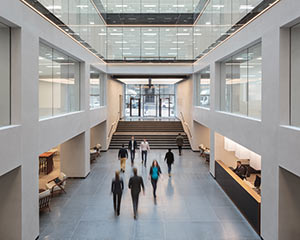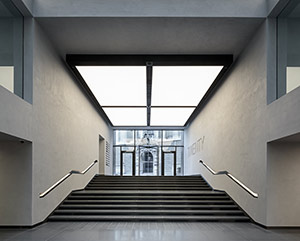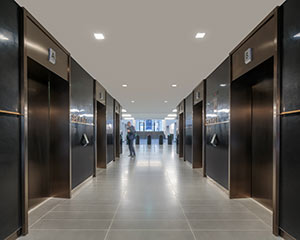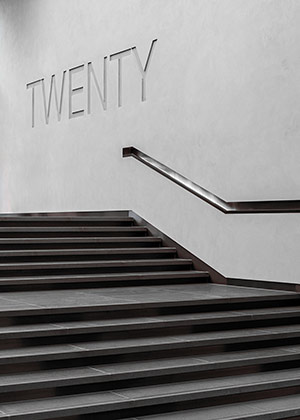Monthly Archives: April 2018
Saniflo Kineduo walk-in shower-bath offers new features
Story

Sanifo – a leading designer and manufacturer of pumps, macerators, shower cubicles, shower trays and inclusively designed bathroom products – has added several new features to its walk-in shower-bath, the Kineduo, making it completely customisable.
Now with the option to choose the brassware and shower, the Kineduo is an ideal choice for versatile, modern living. Select between a T-bar shower or classic model. The overhead rainshower comes complete with taps and water filler.
Also new, are the round overflow filler, which can be purchased separately; an 800mm glass end screen panel added to the offering of the existing 750mm panel; and, a new soft close seat available from June this year.
Kineduo’s practical features include a simple step-in access using a hinged, toughened safety glass door and the bath is available in a variety of sizes and fit options.
Made from fully encapsulated acrylic, Kineduo is extremely robust and long lasting and has a clever adjustable feet system to add stability. Kineduo is available in both right and left-hand versions and with front and end panel colour options, making it suitable for most bathrooms and users.
As standard, the Kineduo comes with a cushioned headrest, a pop-up plug and a toughened safety glass door. The optional extras are then selected to personalise each customer’s Kineduo walk-in shower-bath.
Ann Boardman, Saniflo UK Head of Marketing and Product Development, comments: “With the new additions to the Kineduo bath, the experts at Saniflo have come up with something that is perfectly suited to all styles of living.
“The Kineduo is contemporary and designed to provide stylish, safe bathing for all household members. We are sure that the new Kineduo with its attractive features and completely customisable options will appeal greatly to the less and the more abled, as well as to the oldest and the youngest.”
View Kinedo's profile:
The Minster Building
Story

Armourcoat surface finishes have played a central role in the comprehensive refurbishment of the iconic Minster Building in the heart of London’s business district.
The interior design, by architects BuckleyGrayYeoman for Ivanhoé Cambridge and its development/asset manager Greycoat Real Estate LLP, has created a major repositioning of the building built around the central eight-storey atrium. The ground floor reception is approached by a 30 metre long boulevard from the new entrance on the corner of Mincing Lane and Great Tower Street. The original entrance has also been retained to Minster Court piazza.
Measuring seven metres high and up to eight metres wide, the impressive entrance boulevard has a polished floor of terrazzo with bronze inlays, edged by dark oak. Throughout the entrance and reception spaces, the walls are hand-finished in nearly 2,000m2 of Armourcoat polished plaster together with over 600m2 of the company’s Acoustic Plaster System applied to the ceilings.
Designed to optimize the acoustics of interior spaces, the Acoustic Plaster system offers a clean and smooth mineral surface that can be applied seamlessly over large expanses to both flat and curved surfaces. Comprising of a special mineral wool composite panel that is bonded onto the substrate and finished with a seamless layer, the Armourcoat Acoustic Plaster System offers an elegant marble based plaster finish while allowing sound energy to pass through the surface. The zero VOC system, which consists of 80% recycled material, achieves class ‘0’ fire rating and a class ‘A’ Noise Reduction Coefficient rating.
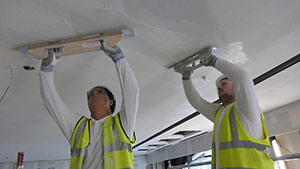
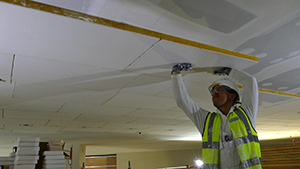
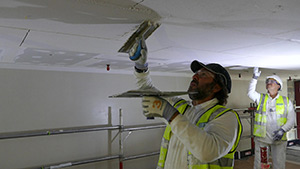
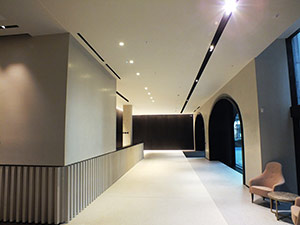

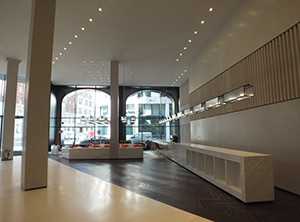
Photography: © Jonathan Banks
View Armourcoat's profile:
How REHAU Recycles
Story

Ever wondered how old PVC-U window frames are transformed into brand new ones? Well wonder no more as Richard Hardstaff, General Manager at PVCR, explains it all:
Q: How easy is it to recycle PVC?
A: PVC is very straightforward to recycle and can be mixed with virgin polymer to give it a whole new lease of life. PVC can be recycled up to 10 times.
Q: Can any recycled plastic be used to make new window frames?
A: The types of material we deal with at PVCR are best recycled into new versions of themselves – so old PVC windows are transformed into new ones, old water bottles are made into new water bottles etc.
Q: Which PVC window frames can be recycled?
A: Ideally we want good quality de-glazed window and door frames to ensure the recycled material is of a good standard. Laminated frames are also OK to recycle.
Q: What processes are involved in recycling PVC?
A: Firstly, the frames are broken down and put into a shredder to reduce the size of the material, and any metal is removed. Next, the material is put in water and essentially everything we want sinks. We then separate the material again using a vacuum to ensure any rubber or leftover metal is removed before it goes into the granulator.
The granulator reduces the material to 10mm in size, before its washed, dried and put through electrostatic separation to remove any remaining residue or organic material. Its then colour sorted before the clean, white PVC material is ready to send to REHAU’s factory in Wales.
Q: What is the PVC material used for in the manufacturing process?
A: After being cleaned and lab tested, the white PVC material is sent to REHAU’s factory in Blaenau, where it used to make TOTAL70 co-extruded profiles.
Q: Is there growing demand for recycled PVC?
A: We have seen a dramatic increase in demand and by 2019 our capacity will have doubled, if not tripled.
Q: What’s the reason behind this uplift in demand?
A: Consumer demand is the main driver. By using recycled plastic, businesses can meet the needs of eco-conscious customers, give their products a USP, and do their bit for the environment.
For more information and to see the process in action visit www.pvcr.co.uk
View Rehau's profile:
Large span windows and doors set new design standard
Story
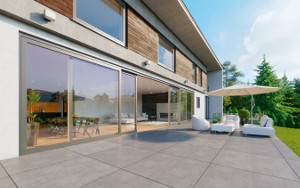
Much has changed in relation to door and window technology over the past 20 years and this is reflected in the increasing popularity of features such as large span roof windows and bi-folding doors. Both are now used as an intrinsic element of interior design as they enable natural daylight to transform areas in which we live and work.
For walls, use of floor to ceiling glazing has enabled exteriors to be ‘brought into’ the living environment, capitalising on views provided and enhancing perceptions of space. Design engineers are now, however, able to maximise the functionality of timber and aluminium to produce far larger sash and frame profiles than ever before. This requires a level of precision beyond the capability of traditional manufacturing techniques while, in terms of design complexity, durability, security and thermal / acoustic performance all have been considerably improved.

The type of timber used for the weight of such windows and doors is critical so Fakro opted for pine, oak and meranti hard woods to provide a combination of high performance and a high visual aesthetic. They also provide long-term structural stability, a critical factor not just for the ability to withstand distortion but to retain energy efficiency and airtightness. This was the driving factor influencing design of the Innoview range, in which triple and quadruple-glazed construction is used with low emissivity glazing and a quadruple sealing system. With warm spacers between panes, the overall heat transfer coefficients in is as low as 0.68/W/m2K (with Ug values of 0.3W/m2K in quadruple-glazed units).
Designs in which windows of such a large span are specified inevitably necessitates manufacture of bespoke sizes for individual projects. In achieving the ability to do so, Fakro can now fulfil the same service it has been providing with roof windows for more than 20 years. This enables architects and interior designers to create homes and work places with a distinctive identity and character while also meeting specific technical aspects of performance.
With scope to specify colours from the RAL Classic Palette and use of close-grain timber from FSC-certified sources, the standard of internal finish immediately provides clear evocation of quality. Modern coating and lacquering techniques, matt or satin finishes and choice of sash profile enable the windows and doors to complement the most diverse interior design requirements. Appearance is enhanced by concealed hinges and invisible fixings while use of sliders in conjunction with a roller lifter and rotary cam ensure that positioning in the frame remains constant, regardless of usage intensity. Soft closure also slows the sash movement prior to positioning it in the frame. Such ease of operation has been described as ‘out of all proportion to what might be expected from windows of such a size’.
EPDM rather than silicone seals are used as they provide far greater long-term reliability through their shrinkage resistance and bond between glazing and frame. This not only gives far greater assurance of air and weathertightness but provides a greatly improved standard of finishing. Windows and doors have anti-burglary, multi-point locks and Class RC1 or RC2 glazing units (the latter optional extra providing nine locking points per window). The hardware also has sufficient strength to provide a load capacity of up to 150kg in standard door and window sizes.
Fixed, arc and multi-sash windows with movable or structural mullion bar, balcony doors with a low aluminium threshold and tilt or lift and slide doors are available. Widths of up to 12 metres and heights up to 2.8 metres as well as non-standard shapes can be accommodated with single or double sash lift and slide doors up to a weight of up to 400 kg.
In terms of design innovation considerable attention has also been paid to external appearance with powder-coated aluminium outer cladding providing a combination of high performance and lasting appearance. The potential to specify the required colour and absence of visible welds at corners provides seamless, contemporary styling.
Products such as Innoview HST doors have virtually no visible while PSK tilt and slide doors provide scope for micro-opening to provide room ventilation without reducing the level of security. Such developments can only provide further incentive to change the face of contemporary fenestration while providing scope to do so in designs up to Passivhaus standard.
View Fakro's profile:
Twenty Old Bailey
Story
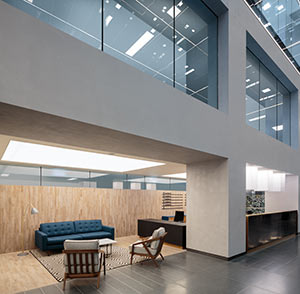
Armourcoat polished plaster wall finishes feature within the major office refurbishment of Twenty Old Bailey by architects BuckleyGrayYeoman for global asset manager Blackstone.
Located opposite the famous criminal courts in the city of London, the building has undergone a comprehensive modernisation programme to create over 22,000m2 of contemporary office space. A reconfigured atrium has also been created, which links the new facades to the East and West of the building, and allows natural light to flood the interior.
Throughout the atrium over 700m2 of Armourcoat ‘KonCrete’ polished plaster has been expertly hand-applied and includes a recessed logo by the entrance. ‘KonCrete’ is an urban range of polished plaster colours and finishes designed for contemporary projects. The range offers a wealth of design options to achieve a distinctive modern look including distressed effects or recessed shutter markings.
Additionally Armourcoat ‘SMG’ was applied to the reception desk front and lift lobbies. ‘SMG’ is a super luxury polished plaster finish with the appearance of a seamless high-gloss lacquer effect. It provides an opulent decorative effect offering great light reflection to create an inviting and spacious interior.
